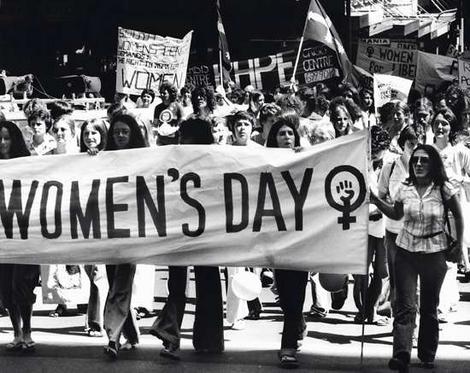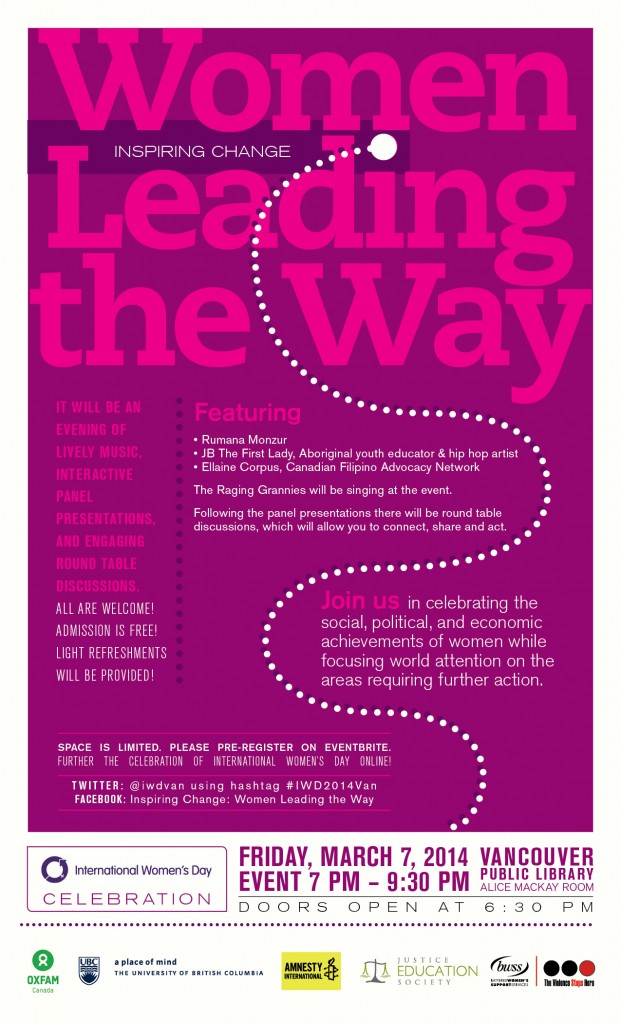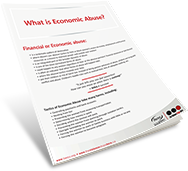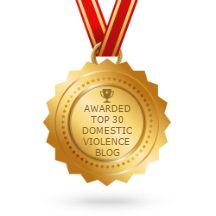by Jessica West
Practicum Student at Battered Women’s Support Services
As a young woman new to the anti-violence movement, I confess that I was ignorant about the origins and purpose of International Women’s Day. This International Women’s Day (IWD) I made a commitment to rectify my ignorance by delving into the history of International Women’s Day, to find out where it came from, how it became such an important day for the women’s movement and why we continue to commemorate it every year. At Battered Women’s Support Services (BWSS), I have the opportunity to learn and share my knowledge with others. This week I interviewed three of the many women who have contributed towards the successful organization of International Women’s Day over the years; Jackie Larkin, who started organizing IWD in Toronto in the early 1970’s, Miriam Palacios from Oxfam, who has organized IWD in Vancouver since 1988, and Rosa Elena Arteaga, BWSS Manager of Direct Services and Clinical Practice, who has been on the IWD Organizing Committee for the last 12 years. All three women shared their perspectives on why International Women’s Day is important to them, how the event can be used to create change and how they hope the event will develop in the future.
International Women’s Day has been and continues to be an important vehicle for inspiring social change and advancing women’s equality. The day has its roots in early 20th century efforts by working class women to fight for their rights in a parallel movement to the efforts of upper class women working for women’s suffrage. In the United States (US), the US Socialist Party established a National Women’s Day in 1909 that was celebrated by a cross-class coalition of socialists, working class women and middle class women. At the same time in Germany, prominent socialist Clara Zetkin promoted the idea of a national women’s day where women could voice their concerns about labour conditions, suffrage and women’s representation in government. She and other delegates of the 1910 Second International Conference of Socialist Women created a National Women’s Day for that purpose. The following year, the first International Women’s Day was celebrated on March 19th by Germany, Denmark, Austria and Switzerland. It later spread to Russia, where it stood for women’s sacrifices in the Bolshevik revolution and their efforts to protest for “bread and peace”.
International Women’s Day was later revived by the second wave feminists in the 1970’s as a way to voice women’s concerns about issues of reproductive rights, gay and lesbian rights, equal pay and women’s right to unionize. 1975, International Women’s Year, was the year that the United Nations sanctioned March 8th as International Women’s Day.
The historical link between International Women’s Day and the women’s movement is what makes IWD an expression of the strength of the consciousness of the women’s movement. That the day has survived for over one hundred years and continues to thrive is a testament to not only the achievements of women of the first and second waves of feminism, but also to the new leadership of racialized and Indigenous women as the event has evolved over time. It is these new layers of women involved in organizing IWD to which Jackie Larkin attributes the success of maintaining the public profile of the women’s movement. The continuation of the women’s movement and women’s struggle for equality has the potential to benefit people of all genders, as Rosa Arteaga believes that women are at the centre of families and communities, and equality for them will create positive changes for men too.
International Women’s Day is a space for simultaneous celebration and struggle. Although we continue to fight for systemic change, we must take the time to celebrate our successes in the middle of that struggle. We celebrate women’s existence, we celebrate our achievements, and at the same time we recognize that there is more work to be done. Rosa explains that celebrating the specific achievements of women will inspire other women still engaged in a similar struggle to continue to fight for the same thing. Rosa invokes the common feminist saying that “I am not free until all women are free” to illustrate how we speak out about the barriers still facing us and draw parallels between the issues we experience locally with the problems women are engaged in globally. The international recognition of the event is one aspect that makes IWD unique in Rosa’s eyes, as she envisions the event as a day where women around the world join hands in unity and in the fight to improve their lives.
This vision highlights IWD’s strength as it lies in its capacity to bring together as many women as possible and to educate and mobilize the public to join the movement. As a space for different women’s groups to come together in conversation and make their work visible, it offers citizens a means to connect with different groups and get involved in the work they are doing, something Miriam Palacios believes is crucial for the fight against inequality to advance in the future. The conversations that take place between different groups also produce common themes and understandings of women’s issues that can then be used to lobby the government for change. Jackie observes that the opportunity for education exists outside of the event itself as women have been able to capitalize on the international legitimacy of IWD to encourage large organizations like governments and unions to commit to IWD and use it as a time to educate their members and promote consciousness of women’s issues.
The expansion of IWD’s influence means that more and more men and young people are becoming involved with the event each year and as social media becomes more popular, Rosa is optimistic that young people will use their access to social media to promote the event and increase participation. Miriam sees potential growth in the form of greater involvement of diverse organizations, not just women’s organizations, working collaboratively on a common agenda to create change. Jackie also hopes for IWD to grow and be widely promoted in all communities, rural and urban. As IWD grows, her dream is for the event to take on the issues of the most marginalized women and that women will amplify their passion and energy around these issues.
Hearing about these women’s hopes for the future of International Women’s Day, as activists who have been involved in organizing the event for many years, I feel inspired to take on these hopes myself and consider what contributions I can make to ensure that the legacy and potential of International Women’s Day continues. I also reflect on this year’s theme, Inspiring Change: Women Leading the Way. As a current organizer of IWD in Vancouver, Miriam explains that this year’s theme is meant to draw attention to the work of women leaders whose contributions are not recognized and to bring to the forefront how important their leadership is for creating change.
I wish to recognize the leadership of these three amazing women and all of the women who have contributed to the organization of International Women’s Day events around the world. Thank you for creating and sustaining March 8th as a day for all of us to celebrate and fight for women’s equality together.
References:
Introduction. In What were the Origins of International Women’s Day, 1886-1920?, by Kathryn Kish Sklar and Lauren Kryzak. (Binghamton, NY: State University of New York at Binghamton, 2000).
http://www.cbc.ca/news/world/history-of-international-women-s-day-1.1010195
http://www.internationalwomensday.com/theme.asp#.UwzvXM1zPr5
Last year, Battered Women’s Support Services responded to over 10,000 crisis calls from women and girls to get help and end violence. We could not provide this essential support without your contribution. 







